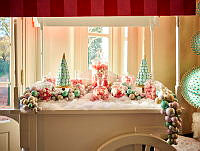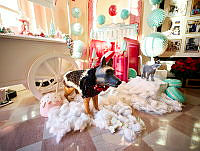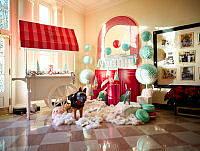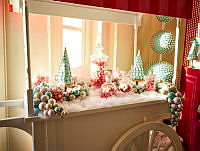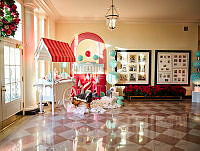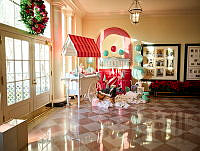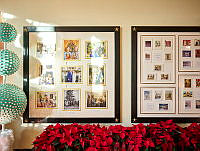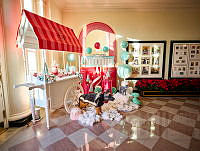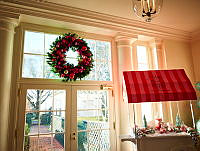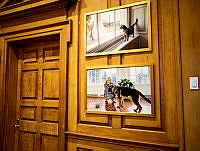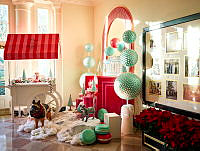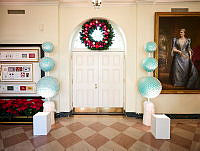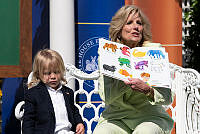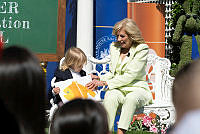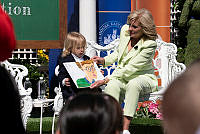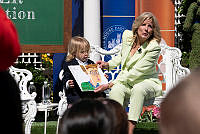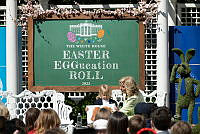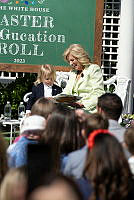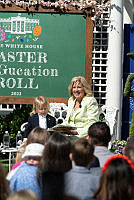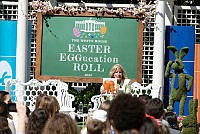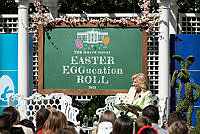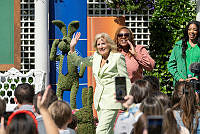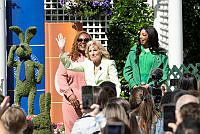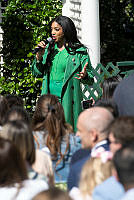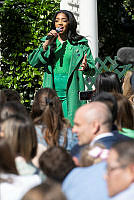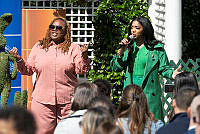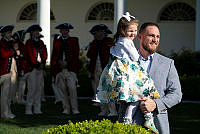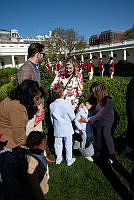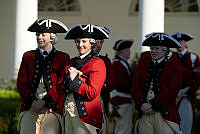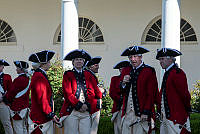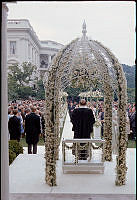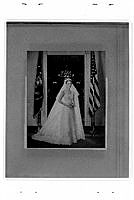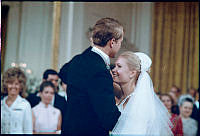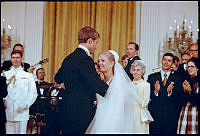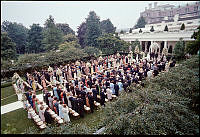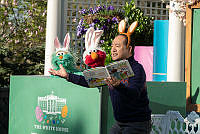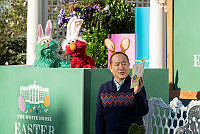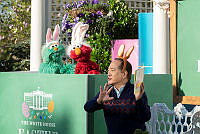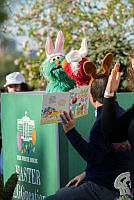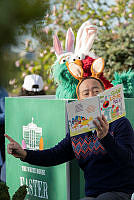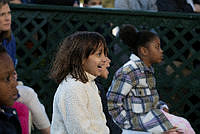Rubenstein Center Scholarship
Raccoons at the White House
Many people consider raccoons to be pests and nuisances. These nocturnal mammals are often found rummaging through trash cans, dumpsters, and alleyways, looking for anything of subsistence. Their scavenging can be quite vexing to property owners and tenants, who are left to clean up the messes they leave behind. The staff of the White House and the National Park Service have mostly kept raccoons off the White House Grounds, but there were several memorable occasions when these animals visited and even lived at the White House.
In January 1914, Democratic National committeeman Edward F. Goltra brought a raccoon to the White House to meet President Woodrow Wilson. Goltra, a St. Louis businessman with extensive experience in the steel, iron, and transportation industries, also carried a coonskin cap with him, hoping to present it to the president as a gift. According to a correspondent for the Washington Post, Goltra and “Ben” the raccoon arrived at the Executive Mansion by way of a taxi cab. When he learned that President Wilson had already left that morning for a round of golf, Goltra tied Ben to a tree and went inside the West Wing. According to the reporter, Ben had been captured by the Randolf County Hunt Club, and “he put up such a fight he lost one of his teeth.” Goltra, who admired the tenacity of the animal, took the raccoon to a dentist, who replaced the missing tooth with a gold one. During their journey to Washington, Ben got into another tussle with a bulldog on a train near Harrisburg, Pennsylvania, emerging from the scrap victorious. Goltra left the coonskin cap for the president, gathered up Ben, and headed to the United States Capitol to visit with Missouri Senator William J. Stone.1

First Lady Grace Coolidge holds Rebecca, the family's pet raccoon, at the White House.
National Photo Company Collection/Library of CongressThe most famous White House raccoon was “Rebecca.” She was given to the Coolidge family in 1926 by a supporter from Mississippi, who suggested that the raccoon be served up for Thanksgiving dinner. Fortunately the family fell in love with her, and instead adopted Rebecca as a pet. That Christmas, President Calvin Coolidge gave her an embroidered collar with the title, “White House Raccoon,” her nickname in the press.2 When the family had to vacate the White House during the 1927 roof renovation, Rebecca moved with them to the Patterson Mansion on DuPont Circle. These quarters proved inadequate for the raccoon, who was then sent to the Rock Creek Zoo temporarily.3 However, Rebecca still joined in the family festivities and annual White House celebrations. On April 18, 1927, the famous raccoon accompanied First Lady Grace Coolidge during the White House Egg Roll. The first lady held Rebecca close to her chest, occasionally setting her down so that children could pet the raccoon. Rebecca remained on a short leash, as she had developed a reputation for evading staffers and climbing trees to avoid capture. According to one account, she enjoyed playing hide and seek with personnel, exhausting them until she was ready to return “to her house on top of a stump” on the White House Grounds.4 Mrs. Coolidge later reminisced that one of Rebecca’s favorite pastimes was “playing in a partly filled bathtub with a cake of soap.”5 When the Coolidges decided to vacation that summer in the Black Hills of South Dakota, they originally planned to bring only their collies Rob Roy and Prudence Prim, along with Mrs. Coolidge’s five canaries. However, they couldn’t bear the thought of leaving Rebecca behind, so they added her to their pet entourage at the last moment.6

First Lady Grace Coolidge takes Rebecca for a walk during the annual White House Egg Roll on April 18, 1927.
National Photo Company Collection/Library of CongressThe American public and media became obsessed with Rebecca. Some hoped that she might find love or companionship while living at the Executive Mansion. An unnamed White House policeman took it upon himself to be the raccoon matchmaker. He captured a male raccoon in northern Virginia, and brought it with him to the White House to serve as Rebecca’s “boyfriend.” His name was Horace, but the president did not care for that name very much. He changed it to Rueben, but this did not improve relations between the two raccoons. Rueben escaped from his cage frequently, scaled the highest trees, and on one occasion climbed the White House fence and leaped onto Pennsylvania Avenue, halting traffic for 30 minutes.7 Rueben’s tenure at the Executive Mansion was short-lived, as he later escaped the grounds and was not found by staff afterwards. Rebecca returned to her place in the spotlight as the official “White House Raccoon,” participating in the White House Egg Roll again in 1928. Visitors played with the animal and enjoyed watching her antics inside her wire enclosure just south of the West Wing. The Coolidges had a special wooden house built for Rebecca, with a panel that flipped up so she could climb in and out easily. However, as they prepared to leave the White House in 1929, so too did Rebecca. The Coolidges wanted her to live with other raccoons, so they sent Rebecca to the Rock Creek Zoo.8

White House Police officer B.B. Snodgrass holds "Billy Possum" by the scruff of the neck at the White House on May 6, 1929. The small house was originally built for Rebecca.
National Photo Company Collection/Library of CongressShortly after the inauguration of President Herbert Hoover, a new creature wandered onto the White House Grounds and moved into Rebecca’s house: “Billy Possum.” Captured by White House policeman B.B. Snodgrass, the wild opossum was adopted by the Hoovers and placed in the pen built for Rebecca. He was borrowed to Hyattsville High School’s baseball team to substitute for their missing opossum mascot later that summer. Billy was eventually returned to the White House, where President Hoover promised “to maintain his health and spirits” and add Billy’s teamwork experience “into his service record.”9 While an opossum now reigned at the Executive Mansion, there was one interesting raccoon visit that took place during the Hoover administration. Susie, a four-year-old raccoon and her six cubs, were invited to President and Mrs. Hoover’s garden party for wounded and disabled veterans in August 1930.10 The idea of raccoons gallivanting at the party was attributed to Chief Usher Ike Hoover, who received the animals from William H. Blackburn, head keeper at the D.C. Zoo. Those present first thought perhaps Rebecca had returned to reclaim what was rightfully hers, but the chief usher quashed that idea quickly. Veterans, foreign dignitaries, and Cabinet officials thoroughly enjoyed watching Susie and her cubs play on the rolling lawns of the White House that day; indeed, they were now part of raccoon nostalgia at the President’s House.11
On September 28, 2020, four mischievous raccoons made headlines when they invaded Pebble Beach, the area set aside for news broadcasts on the North Lawn of the White House. The curious creatures explored the green enclosures, chased off several journalists and photographers, and one even attempted to chew its way into a backpack. While their presence was considered an inconvenience, they were not the first raccoons to roam the White House Grounds and most certainly will not be the last.














